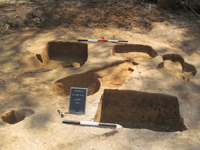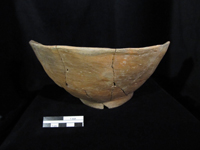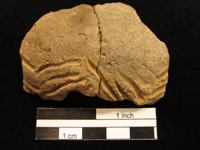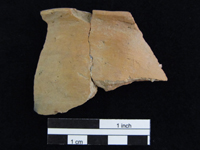
|
| Vol. 21, No. 6 |
August 8, 2013 |
|
|
WSSI Archeologists Discover Rare 18th Century
Slave Overseers Dwelling
|
Thunderbird Archeology Associates, a division of Wetland Studies and Solutions, Inc. (WSSI) recently excavated a mid 18th century slave quarter site (Accotink Quarter) in Fairfax County, Virginia, which has been described as one of the most important archeological sites in Virginia. The unique nature of this site was identified through several landmark discoveries, including the dwelling of a slave overseer and the best preserved assemblage of colonoware pottery ever found in the state.
Slave and Overseer Quarters
Historic research revealed that the Accotink Quarter site was a part of a sprawling Potomac River tobacco plantation owned by the McCarty family and later by Abraham Barnes
During the 18th century the economy of Virginia was largely focused on the production of tobacco by enslaved African or African American laborers. As tobacco cultivation was very labor intensive, planters relied on a 'gang'' system to manage slave labor. Many enslaved men, women, and children lived on outlying quarters and worked each day at planting, tending, harvesting, and processing the tobacco crops under the close surveillance of overseers. |

Archeological data recovery at the Accotink Quarter site involved excavation of the full cellar underlying the overseer's house and the sub-floor pits in the slave dwelling. Five sub-floor pit features were found within the footprint of the dwelling occupied by enslaved laborers on the site in the mid-18th century.
Sub-floor pits are often found in association with housing for the enslaved in Virginia. African or African American bondspeople may have used these pits for various purposes including storage of root vegetables and the concealment of valuable personal possessions or ancestor shrines linked to West African religious practices |
| Outlying quarter farms in the Chesapeake region have not been well documented archeologically. The challenges in locating, identifying, and interpreting such sites has proven difficult over time. The site was originally recorded as a prehistoric camp site following a survey conducted in 1980. Over 30 years later, WSSI archeologists discovered the previously unrecognized and highly significant occupation of the site during the colonial period.
The research conducted by WSSI on the Accotink Quarter site focused on exploring the lives of the overseer and the enslaved laborers that lived on the land in the half-century before the American Revolution. Unlike previously excavated colonial quarter sites in the Chesapeake, the overseer's house and the dwelling for the enslaved laborers at the Accotink Quarter were separated by over 120 feet. This meant that the associated material culture from each could be isolated and the assemblages compared. Intensive archival research was conducted by WSSI during the excavations and the overseer during the last years of the site's occupation was identified as John Marvill from store ledgers recorded in the colonial town of Colchester.
Colonoware Pottery
Archeological excavations at the Accotink Quarter resulted in the recovery of the second largest and the best preserved assemblage of colonoware pottery ever found in Virginia. A total of 1,400 colonoware sherds representing a minimum of 197 vessels were found at the site.
Colonoware is handmade, low-fired earthenware that was produced and used from the early to mid 17th century through the early 19th century. It has been found in archeological sites typically associated with plantation slavery, along the east coast of the United States and in the Caribbean. Whether colonoware was made by enslaved Africans or by Native Americans has been the subject of considerable debate amongst archeologists.
Analysis of the colonoware recovered at the Accotink Quarter site; however, has provided strong evidence that it and similar pottery found at other archeological sites in northern Virginia was a trade ware produced by a remnant Native American population in the region. The wares were probably sold or traded to planters, such as Abraham Barnes and George Washington at his nearby Mount Vernon plantation, and provisioned to the enslaved and overseers.
D.R. Horton, Inc., the property owner and a sponsor of the archeological investigations, has generously agreed to donate the colonoware vessels and other artifacts recovered at the site to Fairfax County. Fairfax County is considering various options for public exhibition of the colonoware including a display at the Herrity Building for Black History Month in February 2014. |
 |
 |
 |
| Several nearly complete colonoware vessels were found during the excavations and sherd mending resulted in the partial reconstruction of numerous fine examples including a bowl with a flanged base (top), a possible jar (middle), and a bowl with incised chevron decoration (bottom).
Bowls and jars are the most frequently found colonoware vessels and other forms are rare. The collection recovered from the Accotink Quarter site also included plates, goblets, cups, and chamber pots. Many of the vessels found at the Accotink Quarter were burnished, or polished to a lustrous sheen by rubbing the pottery with water-worn stones |
| Contributions to the Field of Archeology
Major research issues in the archeology of American plantation slavery during the 18th century including the lifeways and material culture of the enslaved and overseers, ethnicity, agency, and plantation provisioning were reconsidered in view of findings at the site.
Although documentary evidence suggests that an overseer was present at most outlying quarters on Virginia's 18th –century tobacco plantations, historical and archeological data relevant to 18th century overseers was extremely limited prior to WSSI's groundbreaking research on the Accotink Quarter site. Comparative analysis of the Accotink Quarter with other regional slavery sites indicated that previously unidentified overseers may have been present at several other sites. The Accotink Quarter ranks amongst the most important historic archeological sites in Virginia and news of the discoveries at the site spread quickly in the local and regional archeological community. Archeologists and historians from the Smithsonian Institution Museum of Natural History, George Washington's Mount Vernon Estate Museum and Gardens, the Thomas Jefferson Foundation, and the Fairfax County Park Authority volunteered their time to assist in the excavations or the analysis of artifacts and data from the site. WSSI archeologists have subsequently presented the results of research on the Accotink Quarter at several professional conferences and public outreach events.
For more information on this project or WSSI's cultural resource service offerings, please contact Kim Snyder or Boyd Sipe. |
|
|
|
|
 |
|
|